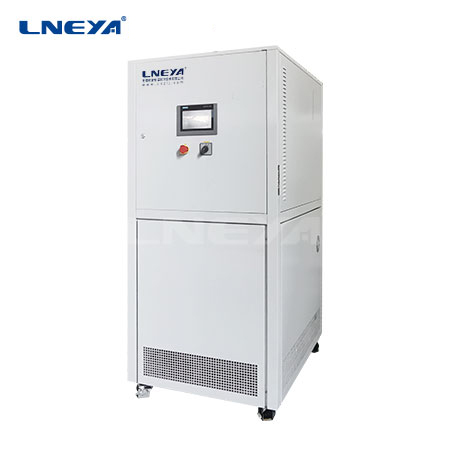Closed Recirculating Cooling Water System
Contact us today for the perfect temperature control solution
A closed recirculating cooling water system uses cooling water to pass through a heat exchanger to cool process media or materials. Through heat exchange, the temperature of the cooling water rises and becomes hot water, and then other cooling media (such as air) are used to cool the hot water. The cooled water is recycled due to the temperature drop.
The secondary cooler uses other cooling media (such as air) to cool the hot water after the temperature has been raised. The secondary cooler is also a heat exchanger. Its outside is often equipped with wing-shaped fins or other shaped heat sinks made of materials with high thermal conductivity (such as aluminum, copper) to increase the heat dissipation area and improve cooling efficiency. . Some designs place the secondary cooler equipped with wing-shaped fins in a mechanical ventilation cooling tower, which can greatly improve the cooling efficiency.
Because the cooling water of the closed recirculating cooling water system is closed and generally has no material exchange with the outside world, the concentration of various minerals and ions in the closed recirculating cooling water system hardly changes.

The characteristic of the closed recirculating cooling water system is that it does not come into contact with the air, but dissolved oxygen still exists in the actual system. This is due to leaks in valves, pipe interfaces, water pump packing, etc., which bring in a small amount of oxygen. In addition, small amounts of supplemental water are also a source of dissolved oxygen. Therefore, there is chemical corrosion of oxygen in the closed recirculating cooling water system. Since the system is usually composed of different metal materials, which may be copper or copper-nickel alloy heat exchange tubes, stainless steel, galvanized steel pipes or mild steel pipes, the closed recirculating cooling water system also has problems caused by different metal materials. electrochemical corrosion. The closed recirculating cooling water system commonly uses softened water as supplementary water, or natural water treated with simple methods as supplementary water.
Closed recirculating cooling water systems are generally only used in industrial production systems with small heat transfer or special requirements, such as air conditioners, generators, internal combustion engines, transformer oil coolers, auxiliary coolers of nuclear reactors, etc. Closed recirculating cooling water systems are generally used for single heat exchange equipment.
Email: info@lneya.com WeChat ID: +8615251628237 WhatsApp: +86 17851209193
 Precision Chillers / Small Chillers
Precision Chillers / Small Chillers
The chiller can be widely used in various industries and laboratories, and supports customized design.
| Temperature range | -18°C ~ +30°C | +5°C ~ +35°C series |
| Cooling Capacity | 0.35 ~ 0.9kW | 1.8 ~ 50kW |

Recirculating Chillers
Our recirculating chiller adopts low-temperature refrigeration technology, the temperature is as low as -120℃, and various accessories are customizable.
| Temperature range | -25°C ~ +30°C series | -45°C ~ +30°C series | -60°C ~ -20°C series | -80°C ~ -20°C series | -120°C ~ -70°C series |
| Cooling Capacity | 0.8 ~ 30kW | 0.75 ~ 12kW | 0.4 ~ 6kW | 0.2 ~ 6kW | 0.3 ~ 5kW |

Low Temperature Chillers
We specialize in the production of low-temperature chillers with a temperature control range as low as -150°C, which can meet the refrigeration needs of different industries.
| Temperature range | -25°C ~ -5°C series | -45°C ~ -10°C series | -60°C ~ -10°C series | -80°C ~ -30°C series | -110°C ~ -50°C series | -150°C ~ -110°C series |
| Cooling Capacity | 12 ~ 360kW | 6 ~ 180kW | 6 ~ 180kW | 4 ~ 180kW | 2 ~ 120kW | 2.5 ~ 11kW |
Temperature simulation for vehicle quality test: battery life test, fuel injector/motor test bench, airbag test, component test bench, etc.

Suitable for precise temperature control of electronic components. In the manufacture of semiconductor electronic components for harsh environments, the IC packaging assembly and engineering and production testing phases include electronic thermal testing and other environmental testing simulations.

Liquid Cooling For Battery Energy Storage Systems
| Types | For Converting Station | For Energy Storage Battery | For Charging Station |
| Cooling Capacity | 45kW | 5 ~ 8.5kW | 4kW |

ZLFQ Series
Coolant Distribution Unit
Liquid cooling equipment is suitable for semiconductor testing, electronic equipment constant temperature testing, cooling server supporting infrastructure, and other fluid temperature control places.
| Temperature range | +5°C ~ +35°C | +5°C ~ +35°C |
| Cooling Capacity | 15 ~ 150kW | 200 ~ 500kW |

MD Thermal Chucks Series
It is used for testing RF devices and high-density power devices (IGBTs and MOSFETs), and can also be used for rapid cooling of laboratory flat panels (plasma, biological products, batteries), etc.
| Temperature range | -75°C ~ +225°C |
| Temperature accuracy | ±0.1℃ |

Screw Chillers (Custom Designs)
Low temperature screw chillers and room temperature screw chillers
| Temperature range | +5°C ~ +30°C | +5°C ~ +30°C | +5°C ~ +30°C | +5°C ~ +30°C | -25°C ~ +5°C | -25°C ~ +5°C |
| Cooling Capacity | 107 ~ 1027kW (Single Compressor) | 299 ~ 2134kW (Dual Compressor) | 98 ~ 934kW (Single Compressor) | 272 ~ 1940kW (Dual Compressor) | 48 ~ 467kW (Single Compressor) | 51 ~ 497kW (Single Compressor) |
 LNEYA
LNEYA
 简体中文
简体中文



















































































